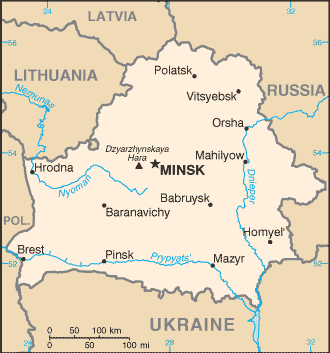|
Belarus
|

|
Capital: Minsk
Population: 9,452,411
Brief History of Belarus:
Some of the oldest archeological evidence of humans has been found in Belarus. Some archeologists think there were people living there as many as 10,000 years ago. Our recent history of Belarus, however, starts in the 6th century AD when Slavic tribes settled there. In 862 the Slavic tribes united with some Scandinavian tribes and formed a state call the Kievan Rus. The capital was the city of Kiev, called Novgorod today.
In the thirteenth century, Belarus became part of the Grand Duchy of Lithuania. Later the Duchy would unite with Poland until the Russian Empire came in and took over the land in 1795. Belarus would be a part of the Russian Empire until collapse in 1918. For a brief time Belarus would declare its independence, only to be taken back over by the Soviet Union in a few years later.
Belarus suffered greatly over then next several decades, first at the hands of Joseph Stalin and then during occupation by the German Nazi Army during WWII. Over 800,000 Jewish people were executed by the Germans in Belarus.
With the collapse of the Soviet Union, Belarus declared its independence on July 27, 1990. The country has been ruled by Alyaksandr Lukashenka since 1994.
The Geography of Belarus
Total Size: 207,600 square km
Size Comparison: slightly smaller than Kansas
Geographical Coordinates: 53 00 N, 28 00 E
World Region or Continent: Europe
General Terrain: generally flat and contains much marshland
Geographical Low Point: Nyoman River 90 m
Geographical High Point: Dzyarzhynskaya Hara 346 m
Climate: cold winters, cool and moist summers; transitional between continental and maritime
Major cities: MINSK (capital) 1.837 million (2009), Barysaw, Salihorsk
The People of Belarus
Type of Government: republic in name, although in fact a dictatorship
Languages Spoken: Belarusian, Russian, other
Independence: 25 August 1991 (from Soviet Union)
National Holiday: Independence Day, 3 July (1944); note - 3 July 1944 was the date Minsk was liberated from German troops, 25 August 1991 was the date of independence from the Soviet Union
Nationality: Belarusian(s)
Religions: Eastern Orthodox 80%, other (including Roman Catholic, Protestant, Jewish, and Muslim) 20% (1997 est.)
National Symbol: mounted knight known as Pahonia (the Chaser)
National Anthem or Song: My, Bielarusy (We Belarusians)
Economy of Belarus
Major Industries: metal-cutting machine tools, tractors, trucks, earthmovers, motorcycles, televisions, chemical fibers, fertilizer, textiles, radios, refrigerators
Agricultural Products: grain, potatoes, vegetables, sugar beets, flax; beef, milk
Natural Resources: forests, peat deposits, small quantities of oil and natural gas, granite, dolomitic limestone, marl, chalk, sand, gravel, clay
Major Exports: machinery and equipment, mineral products, chemicals, metals, textiles, foodstuffs
Major Imports: mineral products, machinery and equipment, chemicals, foodstuffs, metals
Currency: Belarusian ruble (BYB/BYR)
National GDP: $141,800,000,000
** Source for population (2012 est.) and GDP (2011 est.) is CIA World Factbook.
Back to Geography Home Page
